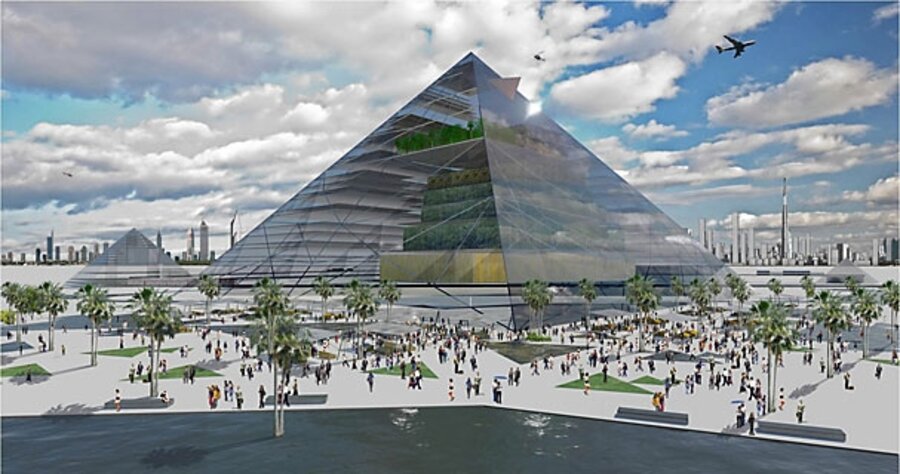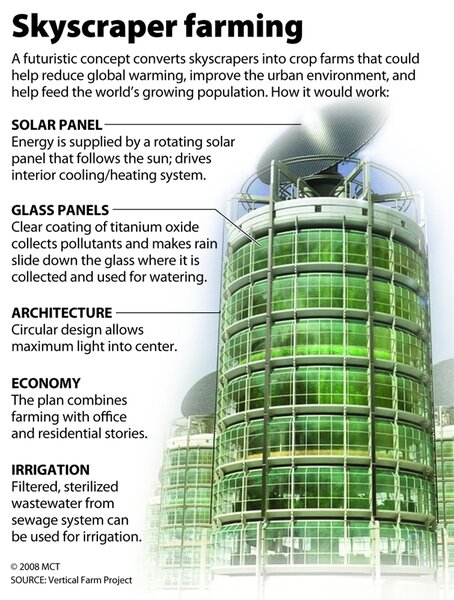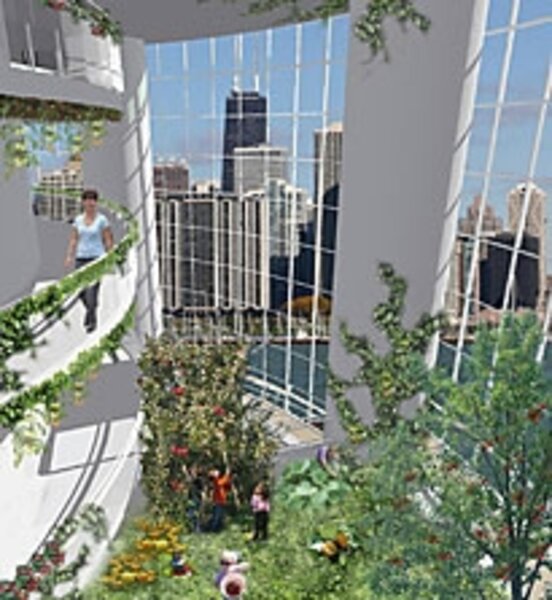Cities may sprout vertical farms
Farming would seem to be a horizontal occupation. Iowa corn or Kansas wheat pokes up from flat fields that stretch to the horizon.
That’s why the idea of “vertical farms” seems ripe for humor. When its biggest advocate appeared on the faux news show “The Colbert Report” earlier this year, comedian Stephen Colbert prefaced the interview by guessing it would have something to do with corn that grows sideways or perhaps “Chia blimps” that float overhead.
Such teasing hasn’t deterred Dickson Despommier, the Columbia University professor of public health. He sees putting crops into skyscrapers as a better way to feed a hungry world. Professor Despommier’s website, verticalfarm.com, features architectural concepts of high-rise buildings that could grow fresh produce in urban areas while at the same time being much more environmentally sustainable than conventional agriculture. [Editor's note: The original story misspelled Dr. Despommier's first name.]
The trouble is, he concedes, none of the beautiful drawings would work exactly as shown. “They all look pretty,” he says. “[A]t least it means they’re thinking in the right direction.”
What’s needed before millions of dollars are spent to construct or renovate an existing 30-story building into a vertical farm, Despommier says, are prototypes just a few stories high. They should be built at leading agricultural universities and tinkered with until the concept is proved. “Once it does, drive it out of the showroom and take it home,” he says.
While Despommier has won admirers around the world for his innovative thinking, skeptics still wonder how he’s going to handle the problem of solar energy – bringing necessary light to the interior and lower floors of his agri-towers. “As soon as you go vertical, you compound that problem of getting that [solar] energy to the plant,” says Gene Giacomelli, director of the Controlled Environment Agriculture Center at the University of Arizona in Tucson.
Dr. Giacomelli likes the audacity of vertical farms, but says a lot of problems must be solved first. Despommier, he says, “is a forward thinker. He’s challenging all of us to try to make it happen.”
The challenges also include finding and training indoor “farmers” who can operate what is likely to be a complex system. “There’s nobody at the moment,” Giacomelli says. The technical problems aren’t insurmountable – crops are being grown indoors at the South Pole, albeit at great expense, he says. But, he adds, “There are many more ways to fail [at indoor agriculture] than to grow a crop correctly and succeed.”
The world is going to need vertical farms because conventional agriculture can’t handle what’s to come, Despommier says. By midcentury, the world is expected to add another 3 billion people, pushing its population close to 10 billion. Feeding all those extra mouths will require finding an area of agricultural land larger than Brazil – without cutting rain forests needed to stabilize the world’s climate.
Heading skyward, under the controlled conditions of an indoor greenhouse, has many advantages, Despommier says. “You can control nothing outdoors, and you can control everything indoors,” he says. That means no floods, wildfires, hailstorms, tornadoes, or droughts. Plant diseases and pests are more easily controlled, too, meaning less need for herbicides and pesticides.
And indoor agriculture is more efficient. One indoor acre of strawberries can produce as much as 30 outdoor acres can. In general, indoor acreage is four to six times more productive, in part because of the year-round growing season. “Outdoors, you might get one crop [per year]; indoors, you might get four or five crops per year,” Despommier says.
By bringing high-rise agriculture to urban areas, transportation costs are eliminated, and the produce is fresher.
The problem of bringing light to the plants could be solved through artificial lighting, powered by solar, wind, or other methods, Despommier says. All cities have a huge source of unused energy: human sewage. It could be burned to create a significant energy source.
“It’s not a perpetual [motion] machine because you’ll have to supplement from the outside,” he says. But the energy requirements would still be lower than those of conventional farming, with its use of heavy machinery, fertilizers, and long-haul transportation.
Critics remain far from convinced. “The notion of filling a building [with plants] and artificially supplying the light for the plants … from any kind of energy system is one of the weirdest ideas I’ve ever heard of,” says Richard Register, author of “EcoCities: Rebuilding Cities in Balance with Nature.” “It’s not serious agriculture. It’s just not.... It’s an intellectual plaything.”
A better answer is to develop, over time, more compact, energy-efficient cities along the European model, he says. That would free up land near urban areas for conventional agriculture with “100-percent-free solar energy” falling on it. Urban community gardens and high-intensity conventional commercial gardens could also supply part of the need.
Despommier’s students, in fact, first looked at using rooftop gardens to feed Manhattan. They found that farming on flat rooftops could supply only about 2 percent of the island’s food needs. That’s when Despommier hit upon using some of the city’s abandoned buildings to create vertical greenhouses.
He received further inspiration from a children’s book his wife gave him. “Old MacDonald Had an Apartment House,” by Judi Barrett, tells the story of an apartment building supervisor who fills his building with vegetable plants and farm animals as tenants. While Despommier doesn’t see cows or pigs moving into vertical farms anytime soon, he thinks aquaculture could be part of the mix.
“You can start with mollusks – mussels and clams,” he says. Shrimp, striped bass, catfish, and flounder are other possibilities – or chickens, ducks, and geese. “This will have to be done in a way that’s agreeable to consumers, so consumers will set the standard,” he says.
The first working vertical farms are likely to be built outside the United States, Despommier says, where the need is greatest. He’s received interest from Shanghai, China, and Abu Dhabi, United Arab Emirates, and is currently on a trip to India to address the Indian Institute for Architecture in Bangalore.
Next spring, a class at the Massachusetts Institute of Technology will look into the idea. Some 15 to 20 seniors majoring in civil and environmental engineering will form teams and create design projects to see just how vertical farming might be accomplished.
“The potential for doing something is great, but frankly I don’t know yet what’s going to happen,” says Herbert Einstein, the engineering professor who will conduct the class at MIT. “If there’s something viable, hopefully we’ll know more by the end of the spring term.”
[Editor's note: The captions for the vertical and horizontal captions were inadvertently reversed in the original version.]







